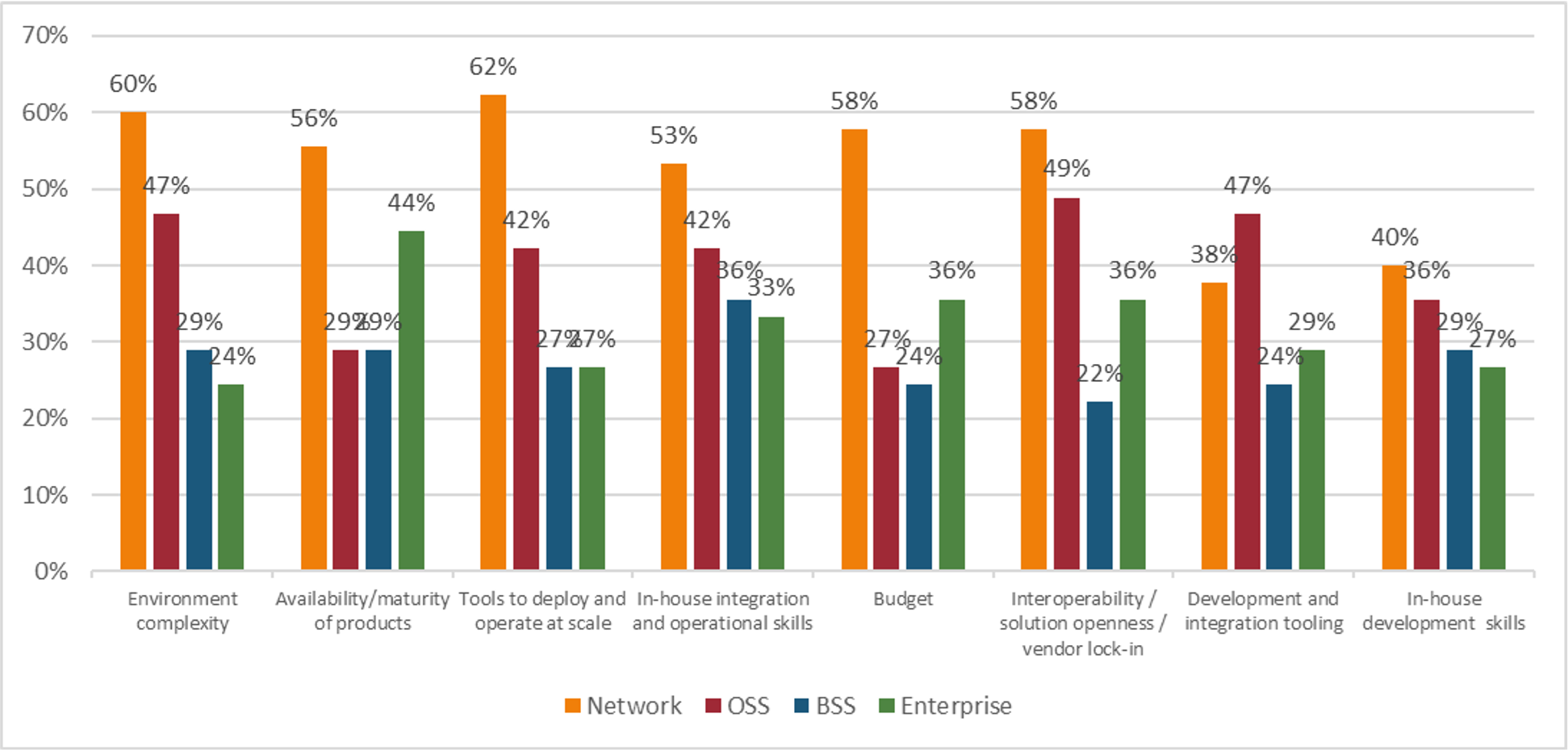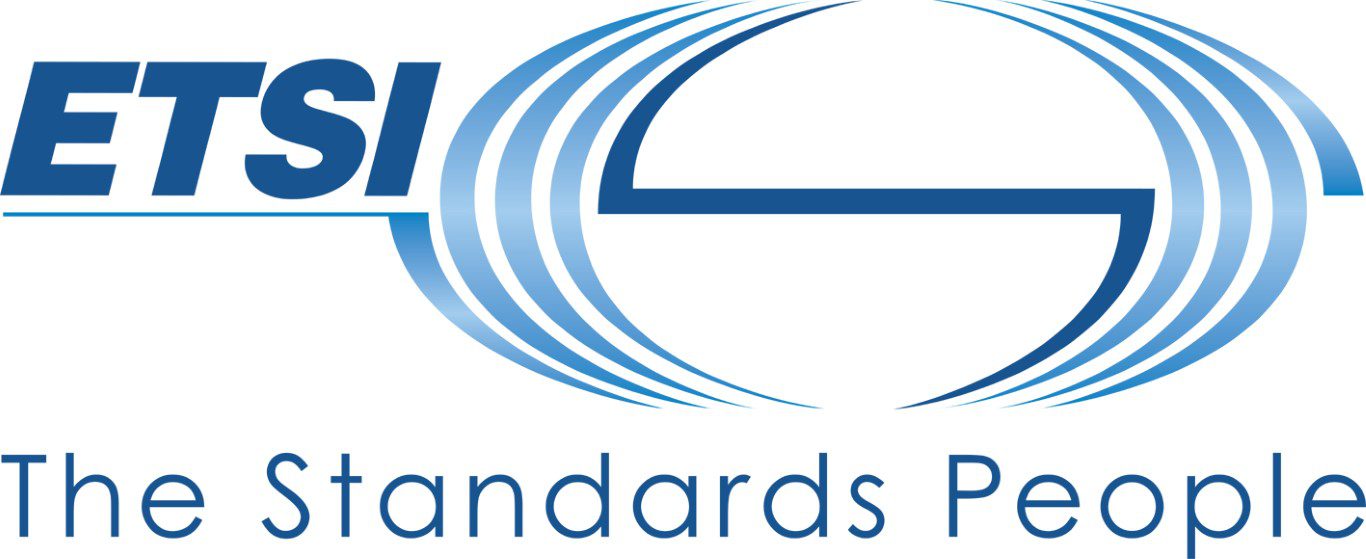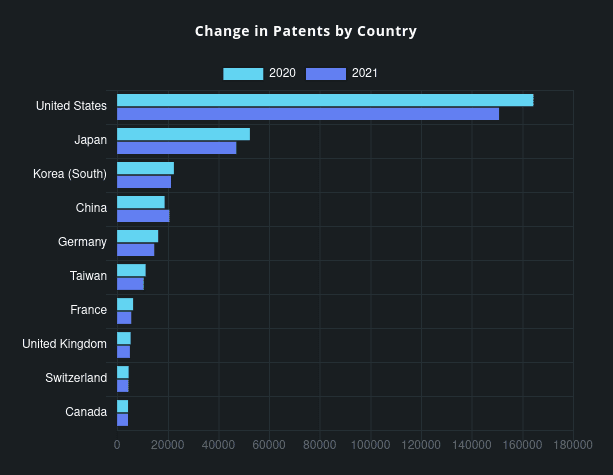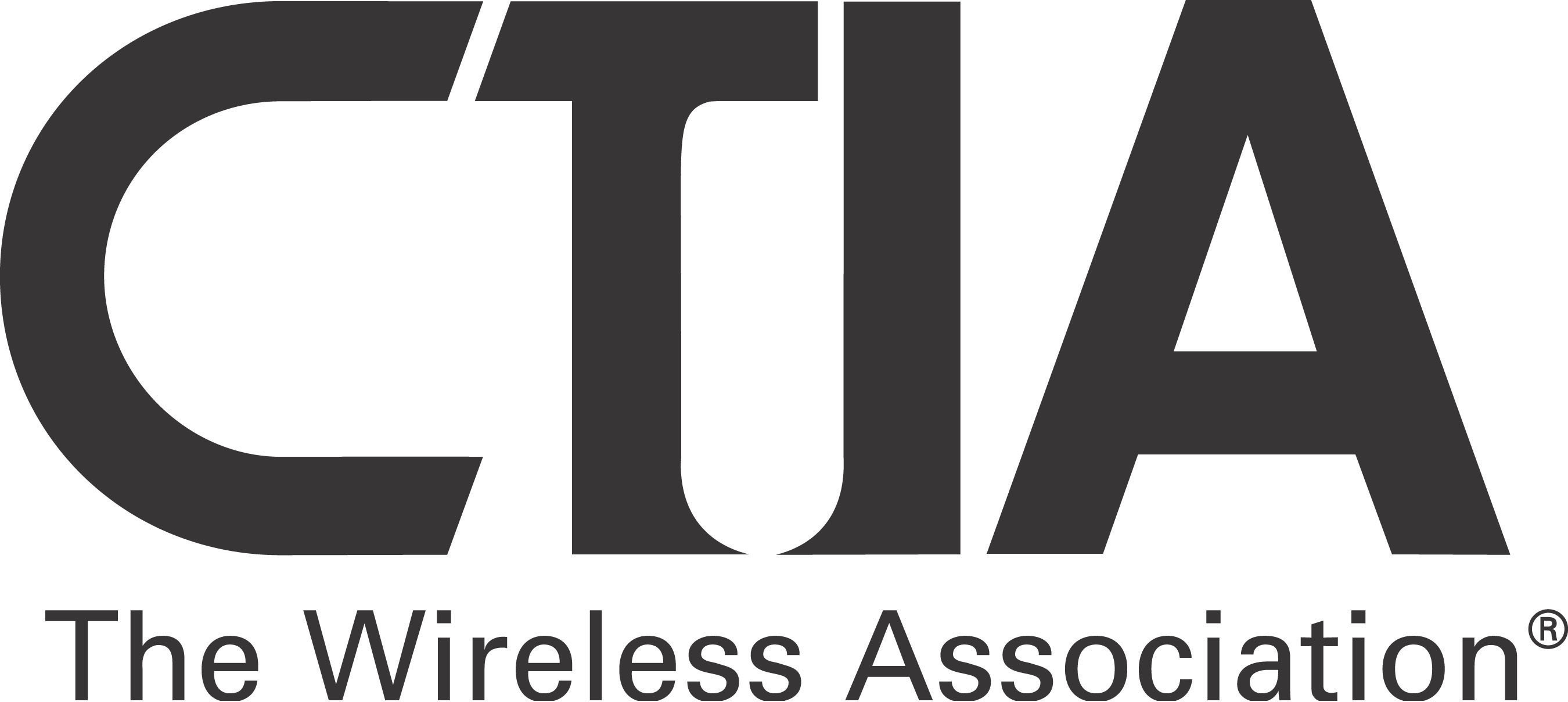NGMN Alliance: Green benchmark for mobile networks
The Next Generation Mobile Networks Alliance (NGMN Alliance) [1.] announced plans to create a new ‘green’ benchmark for mobile networks. The industry standard will be based initially on high-level sustainability indicators, with more detailed assessments to follow. It creates a new way to compare mobile networks, alongside service quality and user experience metrics.
Note 1. The NGMN Alliance (Next Generation Mobile Networks Alliance) is an open forum founded by world-leading mobile network operators. Its goal is to ensure that next generation network infrastructure, service platforms and devices will meet the requirements of operators and, ultimately, will satisfy end user demand and expectations.
NGMN seeks to incorporate the views of all interested stakeholders in the telecommunications industry and is open to three categories of participants (NGMN Partners): Mobile network operators (Members), vendors, software companies and many other leading industry players (Contributors), and research institutes contributing substantially to mid- to long-term innovation (Advisors).
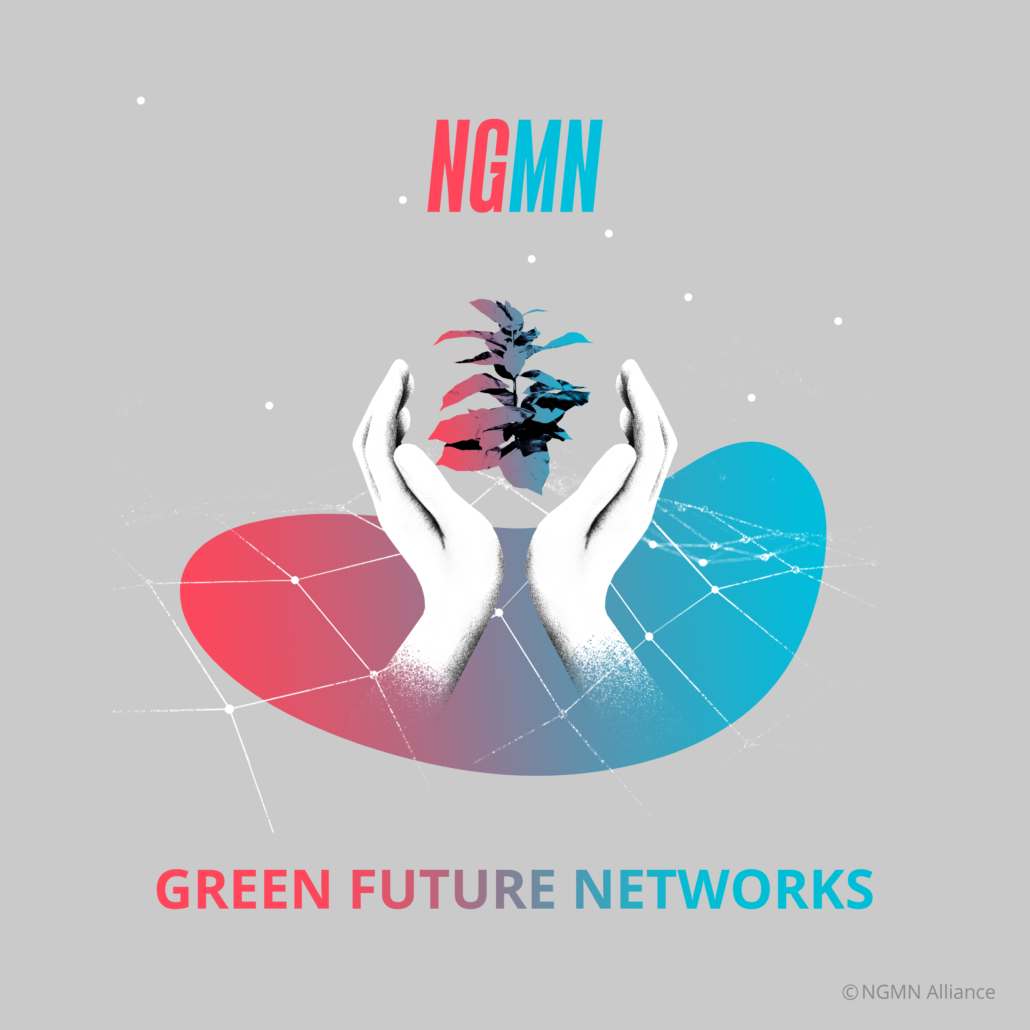
…………………………………………………………………………………………………………………
The new initiative is part of the alliance’s ‘Green Future Networks‘ program, set up in 2020 to help the mobile industry address the need to reduce carbon emissions while network traffic continues to grow. The project aims to improve energy efficiency, reduce carbon emissions and increase the use of recyclable materials. The project will be guided by recommendations made in the NGMN 5G White Paper 2, which focuses on four main areas: on-board metering to control energy consumption; network energy efficiency; eco-design of equipment and products; and end-to-end services footprint.
The general objectives of this NGMN initiative are:
- to establish globally applicable KPIs and methodologies,
- to define a global evaluation methodology, and
- to define the data sources for the assessment and how such data are obtained
With the new benchmark, operators will have an incentive to work on sustainability, as well as a tool to verify and market their credentials to customers and public authorities.
The NGMN initiative plans to establish globally applicable KPIs and methodologies, defining data sources, data collection methods and a global evaluation methodology. Interested industry players are invited to join the project to help develop the new benchmark.
Arash Ashouriha, SVP Group Technology Innovation, Deutsche Telekom and Chairman of the NGMN Board states: ”Implementing concrete actions to mitigate climate action is a key priority for our industry. At Deutsche Telekom, our goal is to make sure that everyone can #takepart and connect over a green network. We are committed to ambitious net zero targets and are continuously optimizing our network to ensure the best quality for our customers while striving to systematically reduce the energy consumption. The Global Green Networks Benchmark from NGMN will certainly help the entire telco industry by providing transparency regarding the operator’s sustainability. In addition, it offers operators a unique opportunity to prove their sustainability credentials towards their customers and be recognized for the positive environmental and societal impact.”
Anita Döhler, CEO at NGMN, emphasizes: “There is a clear need for a Global Green Networks Benchmark. Being recognized for the operation of Green Networks will encourage Mobile Network Operators to engage even more in exploring innovative methods and solutions to implement their networks in an energy efficient manner and to increase the focus on reducing the E2E services’ environmental footprint, for instance, through improved eco-design of products and the implementation of new business models fostering a circular economy. Such efforts will also stimulate supplier innovation.”
NGMN invites interested industry players to join this new endeavor for the benefit of the global ecosystem.
………………………………………………………………………………………………………….
References:
NGMN Defines Industry Standard for a “Global Green Networks Benchmark”
Heavy Reading: “The Journey to Cloud Native” – Will it be a long one?
To gauge how carriers are planning and implementing cloud-native technology, and in collaboration with Juniper, Nokia and Red Hat, Heavy Reading asked 92 global telco service providers about their plans for transition to cloud native. In their report, “The Journey to Cloud Native,” Heavy Reading analyzes the choices service providers are making along the road to cloud native and what challenges they are encountering along the way.
The migration to cloud native brings largescale shifts for the communications service providers (CSPs), including:
- The move to microservices
- Standardized access to these microservices via API exposure
- The integration of multiple operational layers and domains for application management
- Automation across the application lifecycle through the use of DevOps
These are profound changes to the application development and management environment of the CSPs, and will be tackled with dedicated internal resources and expanded partnerships with telecommunication equipment vendors (TEMs), integrators and hyper-scalers (Amazon, Google, Microsoft, Facebook, etc.).
Editor’s Note: There are no standards or implementation specs for “Cloud Native” 5G SA core network or anything else. Rakuten Symphony (Japan) and Reliance Jio (India) claim they are going to implement “Cloud Native” 5G SA core network themselves and sell the specifications and software to other service providers. Good luck! We think it will be a very long journey to cloud native for telecom network operators/5G SA core network service providers.
The prospect of cloud native:
Heavy Reading queried the survey pool about where they were experiencing the greatest challenge in deploying cloud native: the network, operations support systems (OSS), business support systems (BSS), or the enterprise (see Figure 1). Heavy Reading established earlier in the survey that cloud native will be deployed first for network workloads. Respondents plan to transition workloads to the OSS business areas next, then BSS, and lastly, the enterprise.
In almost all cases, respondents ranked the challenges in that same order: first network, then OSS, BSS, and enterprise. The only challenges that were considered more severe in an area other than the network were “in-house development and integration skills” and “development and integration tooling,” where the OSS space was recognized as a greater challenge than the network. This is not surprising given that most Tier 1 carriers have dozens of OSS solutions in operation. They do much of any integration work between systems internally and some OSS systems are stand-alone – dedicated to siloed services.
Figure 1: The network space is seeing the most implementations and the most challenges N=92
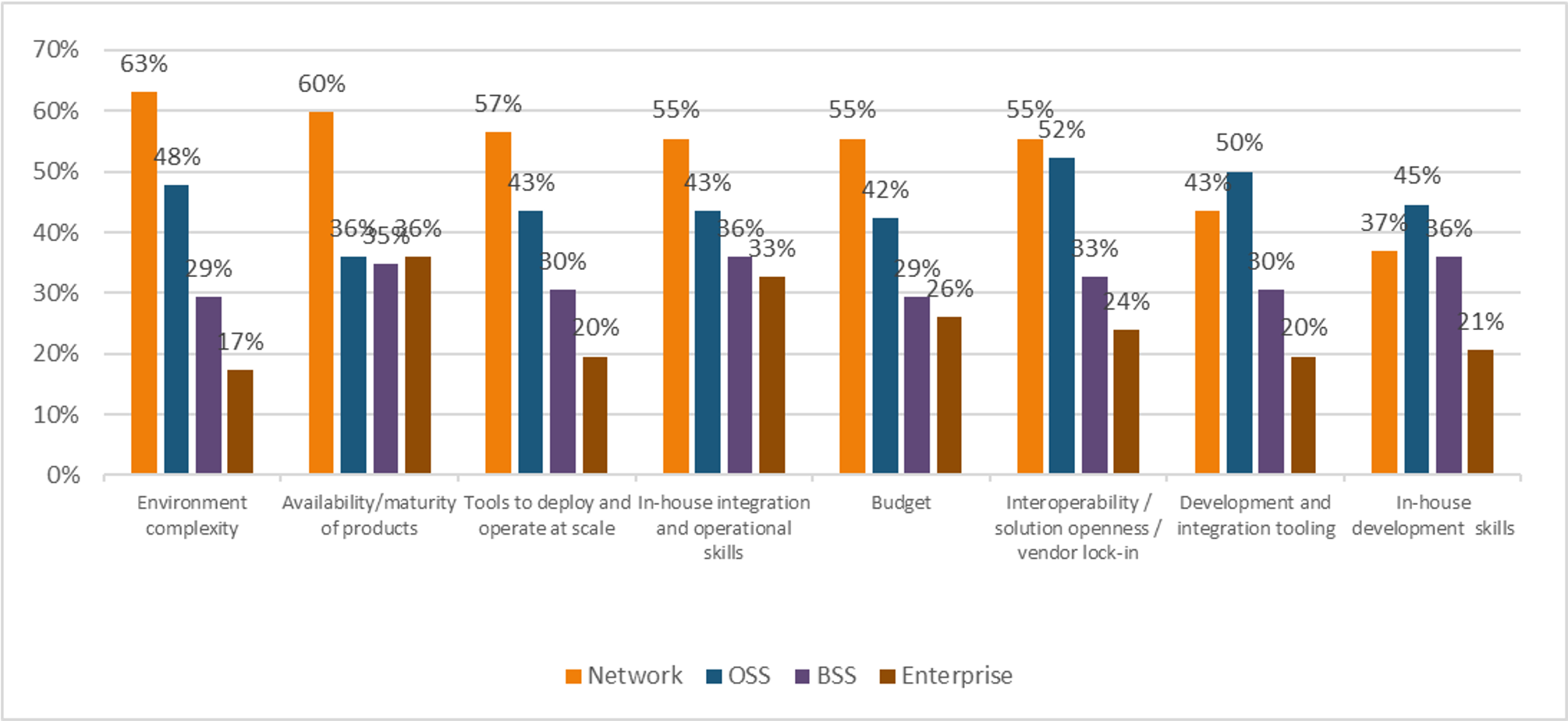
Q: In which business areas are you experiencing significant challenges to going cloud native? Check all that apply. Source: Heavy Reading
……………………………………………………………………………………………………………………………………………………………………………………………………………………………………………………..
Looking only at the survey results from respondents who have already deployed cloud native, (see figure 2), which is half of the respondent pool, there are significant differences compared to the rest of the survey base. In the network area, “tools to deploy and operate at scale” is a greater challenge by 11 percentage points compared to respondents planning to deploy cloud native in one to two years.
“Budget” in the OSS area plummets between those who have not yet deployed cloud native, (57% of respondents considering it a challenge), and those who have already deployed cloud native, (27% of the respondents finding it to be a concern).
Those who have already deployed cloud native also consider all of the challenges in the enterprise area to be greater than the survey base as a whole and all of the challenges in the BSS area to be less of a challenge. Their firsthand experience with implementing cloud native in the network area has opened their eyes to the challenges that await them in the enterprise space. However, they are more confident that they have the support needed, near term, for BSS tasks which include billing, revenue, and customer management.
n=45: only respondents that have already implemented Cloud Native
Source: Heavy Reading
Heavy Reading’s findings might be a good indication that CSPs today are committed to their journey to cloud native, but face daunting challenges that will require expanded partnerships with the cloud-native ecosystem, including platform vendors, ISVs (Independent Software Vendors), TEMs (Telecom Equipment Manufacturers???) and hyper-scalers.
To gain more in-depth details of service providers’ perspective on cloud-native migration, download and read the full report now.
— Jennifer Clark, Principal Analyst, Cloud Infrastructure and Edge Computing, Heavy Reading
References:
https://www.lightreading.com/new-report-highlights-cloud-native-migration-challenges/a/d-id/774623?
https://www.lightreading.com/lg_redirect.asp?piddl_lgid_docid=773720
New partnership targets future global wireless-connectivity services combining satellites and HAPS
NTT, its mobile subsidiary DoCoMo, aircraft maker Airbus, and Japanese satcoms Sky Perfect JSAT Corporation are partnering to conduct a feasibility study on high altitude platform stations (HAPS). Deployed at altitudes of around 20 kilometers, they are essentially flying base stations that can provide coverage to a radius of around 50 kilometers.
Launched with a memorandum of understanding (MOU), the study will attempt to identify the early deployment requirements of a HAPS-based network. The collaboration will investigate the use of the Airbus Zephyr, the leading solar-powered, stratospheric unmanned aerial system (UAS), and the wireless communication networks of NTT, DOCOMO and SKY Perfect JSAT in order to test HAPS connectivity, identify practical applications, develop required technologies and ultimately launch space-based wireless broadband services.
Illustration of Airbus “Zephyr” HAPS aircraft:
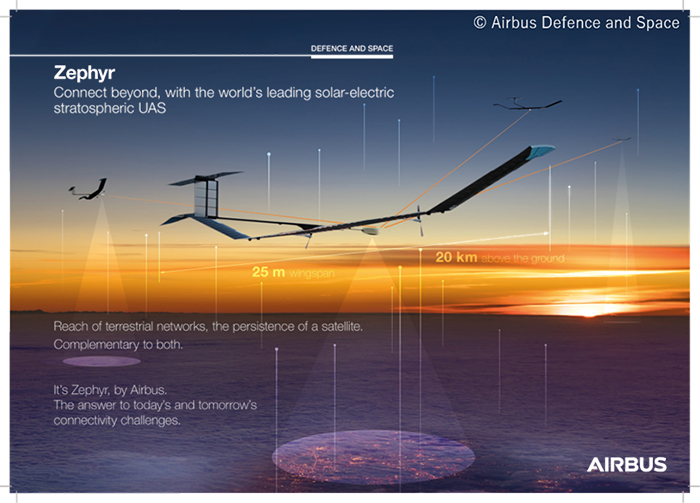
In the global push to further advance 5G and eventually introduce 6G, initiatives are under way to expand coverage worldwide, including in the oceans and in the air. Such initiatives will include HAPS, which fly in the stratosphere about 20 km above the earth, and non-terrestrial network (NTN) technologies using geostationary-orbit (GEO) satellites and low Earth-orbit (LEO) satellites.
HAPS networks are deemed to be a relatively easy solution for air and sea connectivity and an effective platform for deploying disaster countermeasures and many industrial applications. The provision of space-based radio access network services using NTN technologies, collectively called Space RAN (radio access network), is expected to support worldwide mobile communications with ultra-wide coverage and improved disaster resistance as well enhanced 5G and 6G. In addition,
HAPS platforms can also interconnect to the nearest terrestrial network gateway and extend the reach of existing mobile services directly to end-user devices, providing service options including as rural, emergency and maritime connectivity.
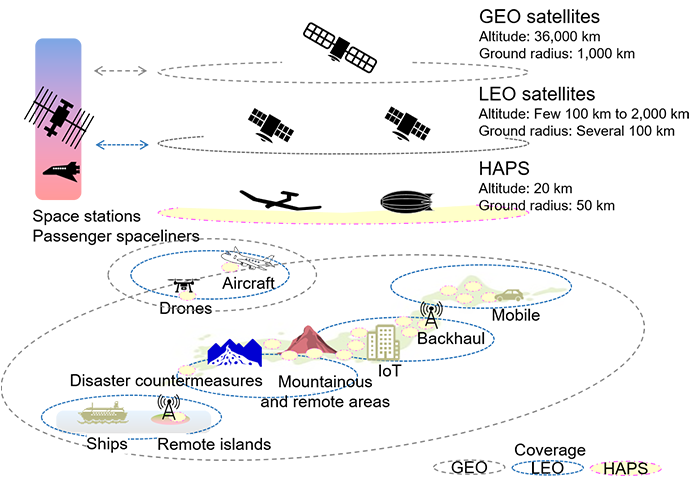
With the signing of the MOU, the four companies will discuss and identify possible future developments necessary to unlock future HAPS-based connectivity services, lobby for standardization and institutionalization of HAPS operations, and explore business models for commercializing HAPS services.
Specific themes will include the applicability of HAPS for mobile connectivity on the ground and base station backhaul,1 the performance of various frequency bands in HAPS systems, the technological considerations for linking HAPS with satellites and ground base stations, and the establishment of a cooperative system to test a network combining NTN technology, satellites and HAPS.
As separately announced on November 15, 2021, DOCOMO and Airbus have successfully conducted a propagation test between the ground and a “Zephyr S” HAPS aircraft in the stratosphere, demonstrating the possibility of providing stable communication with such a configuration.
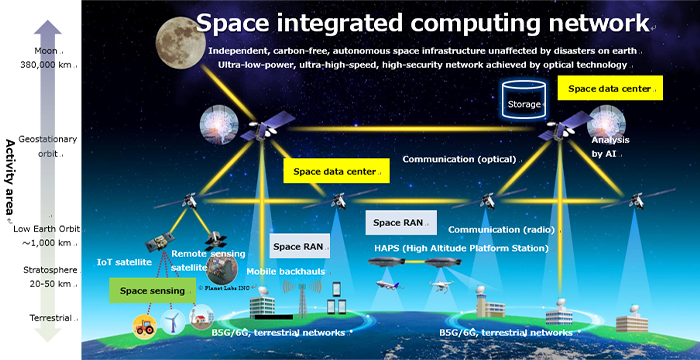
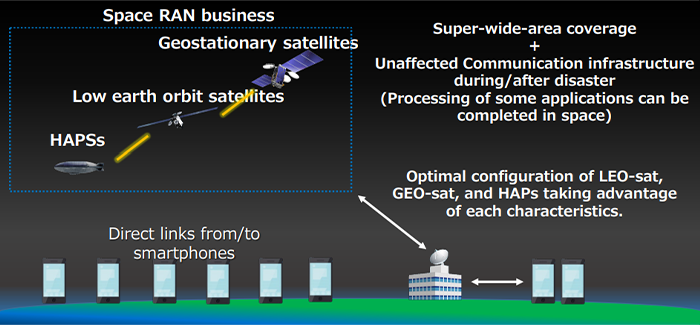
…………………………………………………………………………………………………………….
Nick Wood of Telecoms.com wrote:
If the group achieves its stated objectives, it will have succeeded where a few other big names have failed.
Google, which has a long and rich history of dabbling, had a go at HAPS in 2011. Project Loon as it was called, consisted of a fleet of stratospheric balloons with base stations dangling beneath them. It was spun out of Google’s ‘X’ lab into a standalone company in 2018 and launched its first commercial service in partnership with Telkom Kenya in 2020. However, Project Loon couldn’t drive the costs down low enough to turn it into a viable long-term business, and the whole enterprise ceased operations around this time last year. Alongside Project Loon, Google also flirted with drone-based connectivity. This one was called Project Titan, and it fared even worse than Loon. Test flights began in 2015, but amid rumours of funding issues and technical difficulties, the whole thing was canned in early 2016.
Meta (previously known as Facebook) also had a crack at HAPS. As part of its effort to connect the unconnected and sell their data to advertisers, in 2016 it showed off Aquila: a portable fleet of unmanned, solar-powered drones that would deliver service to rural areas. It gave up on the idea two years later after reaching the not-so-startling conclusion that it wasn’t particularly good at building aircraft.
Despite these high-profile failures, the aviation and telecoms industries are clearly not ready to give up on HAPS just yet. They even launched their own lobby group in February 2020, the HAPS Alliance. Last month it announced the successful test flight of Sunglider, an unmanned, solar-powered aircraft equipped with an LTE base station. Funnily enough, Airbus, DoCoMo and Sky Perfect JSAT are all members of the HAPS Alliance, which aims to create an ecosystem around the technology that will turn it into a sustainable business.
DoCoMo et al are undoubtedly aware of the unproven business case for this technology, and so spreading the risk across several experts – rather than going it alone like Google and Facebook – is probably better than the HAPS-hazard approach taken by those giants of Silicon Valley.
References:
https://www.nttdocomo.co.jp/english/info/media_center/pr/2022/0117_00.html
https://www.nttdocomo.co.jp/english/info/media_center/pr/2021/1115_00.html
NTT hopes to succeed where Google Loon and Facebook Aquila failed
ETSI Experiential Networked Intelligence – Release 2 Explained
ETSI has now completed Release 2 of its Experiential Networked Intelligence (ENI) specifications with the ETSI GS ENI 005 system architecture.
ETSI GS ENI 005 and associated documents will provide better insight into network operations – allowing more effective closed-loop decision making plus better lifecycle management. Through its use, network operators will be able to leverage acquired data and apply artificial Intelligence (AI) algorithms to it. This will mean that operators will be able to respond much quicker to changing situations and gain far greater agility.
The services being delivered across their networks may thereby be rapidly adapted and the resources they have available correctly assigned in accordance with subscribers’ requirements, or any other alterations in circumstances (either operationally or commercially driven).
An industry specification group (ISG) focused on ENI was first established by ETSI five years ago. The organisations involved include many of the leading mobile operators worldwide – full list available here.
ETSI ENI Release 2 defines the key architectural requirements (GS ENI 002), and provides a more comprehensive array of potential use cases (GS ENI 001) and applicable proof of concept (PoC) specifications. To support this release, the ENI ISG has produced a series of reports. These cover data characterization, fault identification, the different types of AI mechanisms that can be employed (along with details of the associated bias and ethical implications), the constituent functional blocks needed for modular design implementations and how to assure their interoperability.
“ENI will have an important part to play in how next generation networks are managed, making them contextually aware and giving them greater inherent flexibility,” states Dr Raymond Forbes, Chair of the ETSI ENI ISG. “Use cases and PoCs are already enabling its validity to be demonstrated, and with ETSI ENI Release 2 we are providing a framework upon which operators and their technology partners can implement it into their infrastructure.”
ETSI’s ENI Release 2 includes the following specifications and reports:
-
- GS ENI 001 Use Cases
- GS ENI 002 Requirements
- GR ENI 004 Terminology
- GS ENI 005 System Architecture
- GR ENI 008 Intent Aware Network Autonomicity
- GR ENI 009 Data Mechanisms
- GR ENI 010 Evaluation of categories for AI application to Networks
- GR ENI 016 Functional Concepts for Modular System Operation
- GR ENI 017 Overview of Prominent Control Loop Architectures
- GR ENI 018 Artificial Intelligence Mechanisms for Modular Systems
From the Systems Architecture Spec:
The ENI System is an innovative, policy-based, model-driven functional architecture that improves operator experience. In addition to network automation, the ENI System assists decision-making of humans as well as machines, to enable a more maintainable and reliable system that provides context-aware services that more efficiently meet the needs of the business.
For example, the ENI System enables the network to change its behaviour (e.g. the set of services offered) in accordance with changes in context, including business goals, environmental conditions, and the varying needs of end-users.
This is achieved by using policy-driven closed control loops that use emerging technologies, such as big data analysis, analytics, and artificial intelligence mechanisms, to adjust the configuration and monitoring of networks and networked applications. It dynamically updates its acquired knowledge to understand the environment, including the needs of end-users and the goals of the operator, by learning from actions taken under its direction as well as those from other machines and humans (i.e. it is an experiential architecture).
It also ensures that automated decisions taken by the ENI System are correct and increase the reliability and stability, and lower the maintenance required, of the network and the applications that it supports. It improves and simplifies the management of network services through their visualization, and enables the discovery of otherwise hidden trends and interdependencies.
About ETSI:
ETSI provides members with an open and inclusive environment to support the development, ratification and testing of globally applicable standards for ICT systems and services across all sectors of industry and society. We are a non-profit body, with more than 950 member organizations worldwide, drawn from 64 countries and five continents. The members comprise a diversified pool of large and small private companies, research entities, academia, government, and public organizations. ETSI is officially recognized by the EU as a European Standards Organization (ESO). For more information, please visit us at https://www.etsi.org/
References:
Multi-access Edge Computing (MEC) Market, Applications and ETSI MEC Standard-Part I
FCC Auction 110 rakes in $22.5 billion in gross proceeds for 3.45 GHz Service
The results of the FCC’s 3.45 GHz auction were announced today. On January 4, 2022, bidding in Auction 110—the auction of new flexible-use licenses in the 3.45–3.55 GHz band—concluded following the close of bidding in the assignment phase.1 Auction 110 raised a total of $22,418,284,236 in net bids and $22,513,601,811 in gross bids, with 23 bidders winning a total of 4,041 licenses.
With $22.5 billion in gross proceeds, Auction 110 was the third highest grossing auction in the FCC’s history.
The 3.45 GHz action makes available 100 megahertz of mid-band spectrum for commercial use across the contiguous United States. Licensees can use it for fixed or mobile uses.
Here are the big winners:
- AT&T: $9.1B
- Dish: $7.3B
- T-Mobile: $2.9B
AT&T won 1,624 licenses in the 3.45 GHz auction, and Dish, bidding under the name Weminuche LLC, won 1,232 licenses. US Cellular acquired 380 licenses, followed by Cherry Wireless LCC with 319. T-Mobile acquired 199 licenses. Meanwhile, Verizon bid =ZERO.
The remainder went to a relatively familiar list of private equity investors, including Grain Capital, Columbia Capital, and Charlie Townsend’s Bluewater Wireless. Here’s the complete list of bidders:
| Bidder | Bidding entity | Winning bids | Licenses won |
| AT&T | AT&T Auction Holdings, LLC | $9 billion | 1,624 |
| Dish Network | Weminuche L.L.C. | $7.3 billion | 1,232 |
| T-Mobile | T-Mobile License LLC | $2.9 billion | 199 |
| Columbia Capital | Three Forty-Five Spectrum, LLC | $1.4 billion | 18 |
| Uscellular | United States Cellular Corporation | $580 million | 380 |
| Whitewater Wireless II, L.P. | $428 million | 14 | |
| Grain Management | NewLevel III, L.P. 0 | $376 million | 8 |
| Moise Advisory | Cherry Wireless, LLC | $211 million | 319 |
| N Squared Wireless, LLC | $101.8 million | 55 | |
| Skylake Wireless II, LLC | $39 million | 57 | |
| Blue Ridge Wireless LLC | $8.9 million | 39 | |
| Agri-Valley Communications | Agri-Valley Communications | $8 million | 7 |
| LICT | LICT Wireless Broadband Company, LLC | $7.7 million | 24 |
| Viaero | NE Colorado Cellular, Inc. | $6.7 million | 18 |
| Nsight | Nsight Spectrum, LLC | $4.7 million | 6 |
| East Kentucky Network | East Kentucky Network, LLC | $4.4 million | 2 |
| Carolina West Wireless | Carolina West Wireless, Inc. | $3.8 million | 11 |
| PVT | PVT Networks, Inc. | $2 million | 6 |
| Chat Mobility | RSA 1 Limited Partnership | $1.7 million | 1 |
| Raptor Wireless LLC | $845,700 | 6 | |
| Horry Telephone | Horry Telephone | $88,060 | 12 |
| PocketiNet | PocketiNet Communications | $59,501 | 1 |
| Jones, Anthony L | $1,575 | 2 | |
| Bidder identity included where available. Source: FCC | |||
The results were pretty much as expected- Dish spent more than expected, and AT&T a bit less, but in rank order and in magnitude, the numbers were relatively close to expectations.

Credit: Getty Images
The “mid-band spectrum” that was auctioned off is considered crucial for mobile operators’ deployment of next generation of wireless service such as 5G, which promises to deliver much faster wireless service and a more responsive network. Mid-band spectrum provides more-balanced coverage and capacity due to its ability to cover a several-mile radius with 5G, despite needing more cell sites than lower-tiered spectrum bands. Its ability to connect more devices and offer real-time feedback is expected to spark a sea change in how we live and work, ushering in new advances like self-driving cars and advanced augmented reality experiences.
“Today’s 3.45 GHz auction results demonstrate that the Commission’s pivot to mid-band spectrum for 5G was the right move,” said FCC Chairwoman Jessica Rosenworcel. “I am pleased to see that this auction also is creating opportunities for a wider variety of competitors, including small businesses and rural service providers. This is a direct result of the Commission’s efforts to structure this auction with diversity and competition front of mind.”
Craig Moffett wrote in a note to clients shortly after the auction results were announced by the FCC:
“After the almost $100B spent on the C-Band auction [1.], these numbers might sound almost quaint. Still, AT&T’s $9B translates to nearly a quarter turn of additional leverage. And for Dish Network, it is roughly two years of EBITDA, or two full turns. As always, spending money on spectrum is only the beginning. Now starts the spending on putting the new spectrum to work. The carriers did not pay up for this spectrum to allow it to languish in a fallow state, and the Towers will be natural beneficiaries of the deployment process over the coming years. Carrier plans for the C-Band suggest that spectrum will ultimately be deployed in a fairly broad-based manner, rather than just in more densely populated areas of the country, and a similar result seems likely for this spectrum, given its broadly similar propagation attributes.”
Note 1. The C-band auction broke records with its $81.2 billion in gross proceeds.
Analysts at New Street Research thought T-Mobile was going to win more spectrum than it did. They were predicting T-Mobile to spend in the range of $6.6 billion and Dish to spend about $5 billion. The FCC is planning for even more auctions in the future.
References:
https://www.fcc.gov/document/fcc-announces-winning-bidders-345-ghz-service-auction
https://www.fcc.gov/auction/110
FCC Auction 110 for mid-band 5G spectrum gets $21.9B in winning bids
https://www.cnet.com/tech/mobile/at-t-and-dish-big-winners-in-latest-5g-auction/
https://www.fiercewireless.com/wireless/att-dish-top-list-fccs-345-ghz-auction-winners
Chinese companies’ patents awarded in the U.S. increased ~10% while U.S. patent grants declined ~7% in 2021
Chinese companies’ patents granted in the United States surged last year, even as total patent awards in the U.S. trended downward, according to a renowned U.S. patent service provider. Data from IFI Claims (more below) showed that Chinese companies’ patents earned in the U.S. increased ~10% to 20,679 in 2021, up from 18,792 in 2020.
The progress came as total U.S. patent grants declined about 7% from 2020 to 327,329 awards last year, the most precipitous drop in the past decade, said IFI Claims.
Several Chinese companies are now among the Top 50 in U.S. patent rankings, including world’s #1 chip maker Taiwan Semiconductor Manufacturing Co (TSMC) at No 4, telecom giant Huawei at No 5, display maker BOE at No 11, tech heavyweight Oppo at No 49, while China’s Advanced New Technologies was ranked #43. Oppo was granted 719 patents in the U.S. last year, marking a surge of 33% year-on-year.
When it comes to total global patents held, China possesses 29% of the global 250 patent families – collections of patent applications covering the same or similar technical content – compared to the U.S. (24%) and Japan (19%), said IFI Claims.
A deeper analysis shows that the U.S. and Japanese portfolios are stronger and more mature. Nevertheless, it is clear that China has stimulated a research and development culture that is serious about intellectual property, said Mike Baycroft, CEO of IFI Claims Patent Services in a statement (see below).
The progress comes as Chinese companies increasingly strengthen their R&D push. Huawei, for instance, invested 141.9 billion yuan ($22.3 billion) in R&D in 2020, accounting for about 15.9% of its revenue.
Jason Ding, head of the intellectual property department at Huawei, said earlier that the company has become one of the world’s largest patent holders through investment in innovation.
Oppo is also beefing up its R&D push. Chen Mingyong, CEO of Oppo, said earlier that the company aims to be a tech pioneer by increasing R&D spending.
“We’ve been working hard for many years to ramp up our products,” Chen said. So far, Oppo has filed for patents in more than 40 countries and regions around the world as it accelerates efforts to expand its global business. As of Dec 31, 2021, Oppo had filed 75,000 patent applications globally, and its global number of authorized patents exceeds 34,000, the company said.
For more information, email: [email protected]
…………………………………………………………………………………………………………………………….
IFI Claims Patent Services – China Surges, as Others Decline:
In a year that saw U.S. patent grants decrease anywhere from 8 to 12% among worldwide corporations, China-based companies stood out with an increase of 10 percent, going from 18,792 awards in 2020 to 20,679 during the past year. A total of four Chinese companies are now in the U.S. Top 50 including Huawei at #5, BOE at #11, Advanced New Technologies at #43, and Guangdong Oppo at #49. US company grants were down commensurate with the worldwide total decline, 8%.
“Last year saw the steepest decline in patent grants in the past decade. There could be many reasons for this – and clearly some are pandemic-related – but what we’re seeing is that corporations are still innovating at an impressive clip despite a challenging environment, particularly U.S. and Asia-based entities,” said Mike Baycroft, CEO of IFI CLAIMS Patent Services.
Consistent with the overall decline in U.S. patent activity from 2020 to 2021, all regions except China had a negative growth rate Year over Year (2021 vs 2020). That is depicted on this chart:
Source: IFI Claims Patent Services
………………………………………………………………………………………………………………………………………………………………………………………………
References:
https://mobile.chinadaily.net.cn/cn/html5/2022-01/14/content_013_61e07f4ced500fb050170922.htm
IPS Expands Long Haul Submarine Data Transmission Capacity with Ribbon’s 100 Gigabit Ethernet (100GbE) services
Ribbon Communications Inc, a global provider of real time communications software and IP Optical networking solutions to service providers, enterprises, and critical infrastructure sectors, today announced that Tokyo based IPS (a leading provider of international connectivity services for communications service providers), is using Ribbon’s Apollo Optical Networking solution to power 100 Gigabit Ethernet (100GbE) services delivered over both terrestrial and undersea cables from Manilla to Hong Kong and Singapore.
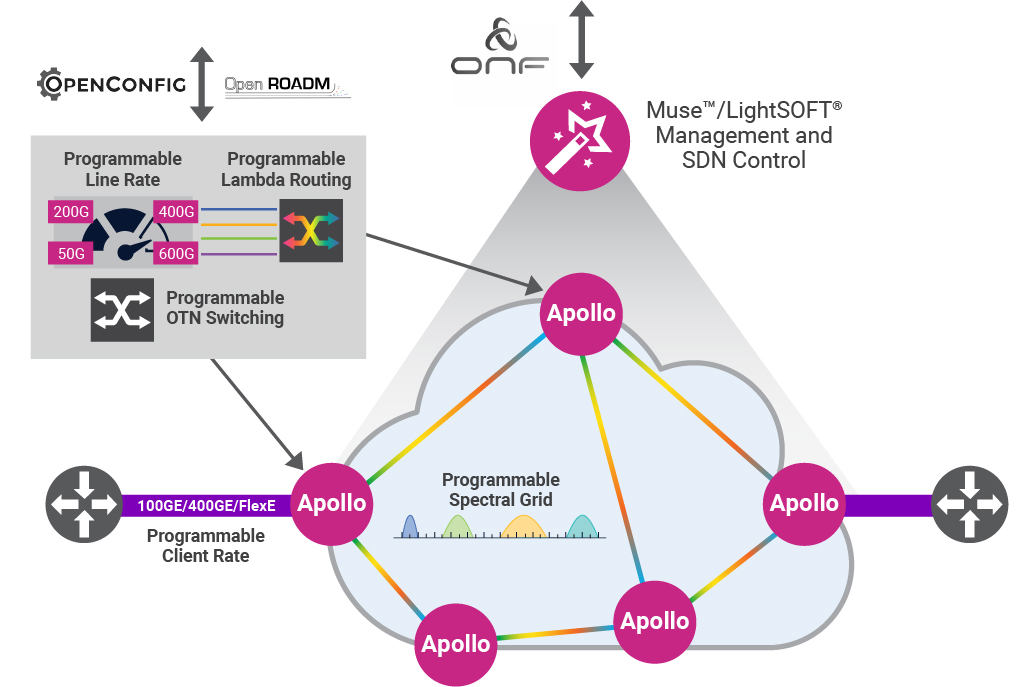
“Our ability to seamlessly deliver connectivity services to our customers over long distances is key to the success of our business,” said Koji Miyashita, President and CEO, IPS. “Ribbon’s Optical transport technology allowed us to maximize our available capacity and transmit world-class communications applications via our submarine services under the South China Sea.”
“Submarine applications must deliver extensive capacity and carry the highest level of communications services on each channel in order to realize cost efficiencies,” said Mickey Wilf, General Manager APAC and MEA Regions for Ribbon. “Our Apollo solution enables IPS to maximize capacity by leveraging dual wavelengths with programmable baud rate and modulation, in conjunction with flex grid technology.”
The solution deployed by IPS leverages Apollo’s high-performance programmable TM800 muxponder cards on Apollo 9600 series platforms to provide optimized long haul undersea connectivity for 100GbE services.
| 9504D | 9603 | 9608 | 9608D | 9624 | ||||
| Size | 1RU | 2RU | 5RU | 5RU | 15RU | |||
| Line Capacity | 1.6T | 2.4T | 6.4T | 6.4T | 19.2T | |||
| Photonics | CDC-F ROADMs, Fixed and Dynamic Amplifiers | |||||||
| Datasheet | Apollo 9504D | Apollo 9603 | Apollo 9608 | Apollo 9608D | Apollo 9624 | |||
| Image | Data Center |
 |
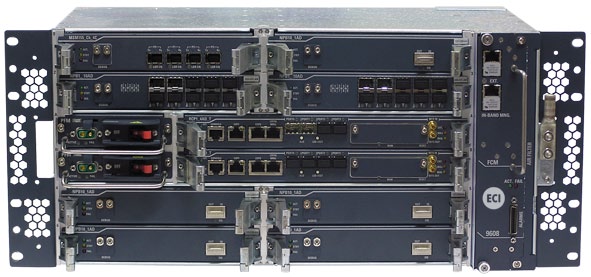 |
Data Center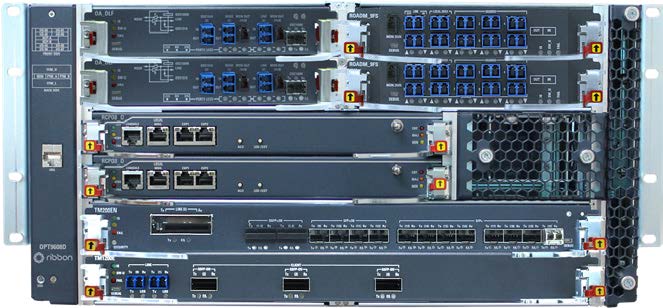 |
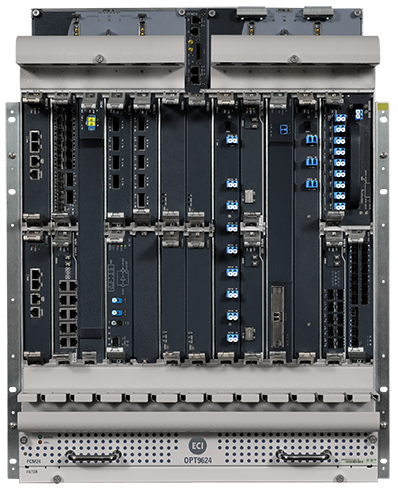 |
|||
About IPS:
IPS Inc. operates as a Carriers-of Carrier in the Philippines providing network services for local and international telecom companies, contact centers and data centers. It has international telecommunication lines connecting Manila with Hong Kong, Singapore, and many other countries. IPS is listed on the Tokyo Stock Exchange.For more information visit ipsism.co.jp/en/.
About Ribbon:
Ribbon Communications (Nasdaq: RBBN) delivers communications software, IP and optical networking solutions to service providers, enterprises and critical infrastructure sectors globally. We engage deeply with our customers, helping them modernize their networks for improved competitive positioning and business outcomes in today’s smart, always-on and data-hungry world. Our innovative, end-to-end solutions portfolio delivers unparalleled scale, performance, and agility, including core to edge software-centric solutions, cloud-native offers, leading-edge security and analytics tools, along with IP and optical networking solutions for 5G. To learn more about Ribbon visit rbbn.com.
References:
https://ribboncommunications.com/products/service-provider-products/apollo-optical-systems
CTIA Announces 5G Security Test Bed for Commercial 5G Networks
CTIA today announced the launch of its 5G Security Test Bed (STB), a security testing and validation initiative dedicated to commercial 5G networks. CTIA created the STB in partnership with organizations across wireless, tech, and academia to test 5G security recommendations across real-world conditions using commercial-grade equipment and facilities.
The 5G Security Test Bed’s founding members—AT&T, Ericsson, T-Mobile, UScellular, MITRE, and the University of Maryland (UMD)—contribute invaluable industry expertise that strengthens the STB’s ability to enhance the wireless security ecosystem and ensure strong protections on 5G networks.
There are no ITU standards for 5G security, which requires a 5G SA Core network. Rather, there are 3GPP 5G Security technical specifications (TS 23.501 – 23.503) with ALL features required to be implemented by vendors, but none of them mandatory for 5G network operators. IEEE Techblog articles and tutorials for 5G security are here.
The STB was created to build on 5G security (presumably from the referenced 3GPP technical specs), testing use cases, making recommendations, and further bolstering 5G’s security to benefit consumers, enterprises, and government.
Governed by industry leaders, guided by government priorities, and managed by CTIA, the test-bed is the latest in a series of steps the industry has taken to make 5G the most secure network ever. Its founding members developed the initiative through their participation in CTIA’s Cybersecurity Working Group, which convenes the world’s leading telecom and tech companies to assess and address the present and future of cybersecurity.
The STB primarily focuses on verifying the Federal Communications Commission’s (FCC) Communications Security Reliability and Interoperability Council (CSRIC) VII recommendations for 5G networks. The FCC announced the working group members of the council last month. There are six CSRIC VIII working groups:
-Working Group 1 is centered on 5G signalling protocols security and is co-chaired by Brian Daly of AT&T and Travis Russell of Oracle.
-Working Group 2 focuses on promoting the security, reliability, and interoperability of Open RAN equipment. It is co-chaired by Mike Barnes of Mavenir and George Woodward of the Rural Wireless Association.
-Working Group 3 focuses on using virtualization to promote security and reliability in 5G, co-chaired by Micaela Giuhat of Microsoft and John Roese of Dell
-Working Group 4 is centered on 911 service over Wi-Fi and is co-chaired by Mary Boyd of Intrado and Mark Reddish of APCO.
-Working Group 5’s area of focus is on managing software and cloud services supply chain security for communications infrastructure; the group is chaired by Rittwik Jana of VMWare.
-Working Group 6 will work on issues surrounding the use of mobile device applications and firmware for wireless emergency alerts. It is co-chaired by Farrokh Khatibi of Qualcomm and Francisco Sanchez of Harris County, Texas’ OHSEM.
The STB will also serve as a valuable industry resource for CSRIC VIII, focused on 5G security, which launched in June, and includes CTIA SVP and CTO Tom Sawanobori among its members.
“This initiative will complement and bolster the FCC’s 5G security efforts, validate its recommendations, and demonstrate 5G security features, with cross-industry groups working collaboratively to test use cases and products on an actual 5G network using real-world hardware and software,” said Sawanobori.
The test bed’s first configuration, built with Ericsson equipment, mirrors the initial setup for most 5G networks—a 5G radio access network is connected to a 4G core to create a 5G non-standalone (NSA) network. In 2022, the STB’s configuration will shift to a 5G standalone (SA) network using a 5G core, which will enable testing of 5G SA use cases.
The STB is located at a secure lab facility at the University of Maryland, leveraging personnel with extensive experience in wireless security. The wireless core network is hosted in Northern Virginia by MITRE, a not-for-profit research and development company.
The 5G Security Test Bed’s evaluations and recommendations cover issue areas that will help transform cities, government, and industries. Applications include autonomous vehicles, immersive augmented reality and virtual reality, automated factory operations, private 5G networks for enterprises, and much more.
5G STB Member Quotes:
“We are excited to have a network dedicated to testing security, which is paramount for the success of 5G. This effort builds on the work underway in standards setting bodies, such as 3GPP, and will enable the industry to demonstrate 5G security in a real-word setting for consumers, enterprise businesses and government.” — Chris Boyer, VP, Global Security and Technology Policy, AT&T
“Ericsson has worked closely with operators to provide the latest equipment to expand secure 5G networks and devices across the nation. We are pleased to play a major role in this next critical step in ensuring robust 5G security for all users. Critical Infrastructure, in particular, must have secure and resilient communication end to end, while maintaining the trust and integrity of its supply chain. Ericsson is proud to be such a trusted supplier, as we provide much of that next-gen equipment from our 5G Smart Factory in Lewisville, TX and services from across the U.S.” —Jason Boswell, VP and Head of End-to-End Security, Ericsson North America
“5G is the most secure generation of wireless networks to date, and we are dedicated to enhancing those protections even further. We’re thrilled that the 5G Security Test Bed will provide an environment to assess potential threats to 5G security raised by security researchers.” — Drew Morin, Director, Federal Cyber Security Technology and Engineering Programs, T-Mobile
“The work being done by this collaborative group to evaluate and validate assumptions is important for protecting the integrity and security of 5G data. We’re looking forward to contributing to the security of 5G for consumers, business and government, now and as the technology continues to evolve.” — Narothum Saxena, Vice President of Technology Strategy & Architecture, UScellular
“Securing 5G networks is whole-of-nation problem with significant implications for our economic and national security that requires collaboration across industry and government. Ensuring the next generation of wireless networks is secure and reflective of democratic values will provide an invaluable foundation for further innovation.” — Charles Clancy, Senior Vice President, General Manager, and Chief Futurist, MITRE Labs
“At UMD, we pride ourselves on training the next generation of engineering leaders and conducting research that advances network and device performance and security. This industry collaboration greatly enhances our ability to meet those objectives.” — Wayne Phoel, Ph.D., Visiting Research Engineer, Institute for Systems Research, University of Maryland
Additional information about the 5G Security Test Bed and how to participate is available at www.5GSecurityTestBed.com.
About CTIA:
CTIA® (www.ctia.org) represents the U.S. wireless communications industry and the companies throughout the mobile ecosystem that enable Americans to lead a 21st century connected life. The association’s members include wireless carriers, device manufacturers, suppliers as well as apps and content companies. CTIA vigorously advocates at all levels of government for policies that foster continued wireless innovation and investment. The association also coordinates the industry’s voluntary best practices, hosts educational events that promote the wireless industry and co-produces the industry’s leading wireless tradeshow. CTIA was founded in 1984 and is based in Washington, D.C.
References:
https://techblog.comsoc.org/category/5g-security/
Will 2022 be the year for 5G Fixed Wireless Access (FWA) or a conundrum for telcos?
Lightshed Partners says absolutely! “This is the year for 5G Wireless Home Broadband,” as it emerges as a viable competitor to cable based Internet access.
The market research firm believes that the recent deployment of large blocks of spectrum by wireless operators will enable them to offer viable home broadband service to a notable segment of the market.
T-Mobile is already adding more than 200k home broadband subs per quarter, and Verizon is about to unleash rate plans that drop as low as $25/month. Verizon is also layering additional commission opportunities for their sales group. The vast majority of cell phone upgrades in the U.S. are still done in a cellular operator’s store. That provides wireless network operators with a familiar opportunity to sell home broadband and they are incenting their salesforce to do so.
Fixed wireless access (FWA) services into homes and offices, have approximately 7 million users around the U.S. The new efforts by Verizon and T-Mobile appear poised to push the technology into the cable industry’s core domain.
“We forecast that Verizon and T-Mobile will add 1.8 million wireless home broadband customers in 2022, more than doubling the 750,000 added in 2021,” the LightShed analysts forecast. “To put that growth in context, Comcast, Charter and Altice combined added 2.4 million broadband subscribers in 2021 and 2.7 million in 2019. Investors expect these three cable companies to add more than 2 million broadband subs in 2022, but even that reduced level of growth from recent years may prove to be too aggressive.”
5G fixed wireless access (FWA) services could serve 8.4 million rural households—nearly half the rural homes in the U.S.—with a “future-proof”, rapidly deployable, and cost-effective high-speed broadband option, according to a new Accenture study commissioned by CTIA, the wireless industry association.
Other analysts agree. “Fixed wireless probably cost Comcast and Charter, in aggregate, about 180,000 subscribers in the second half of 2021,” wrote the financial analysts at Sanford C. Bernstein & Co. in a recent note to investors.
“The great risk seems to lie in late 2022 and 2023. As Verizon, T-Mobile and AT&T deploy initial and subsequent blocks of C-band spectrum and as T-Mobile expands its 2.5GHz coverage to the last 1/3rd of US households, the availability of fixed wireless should expand,” Bernstein analysts wrote.
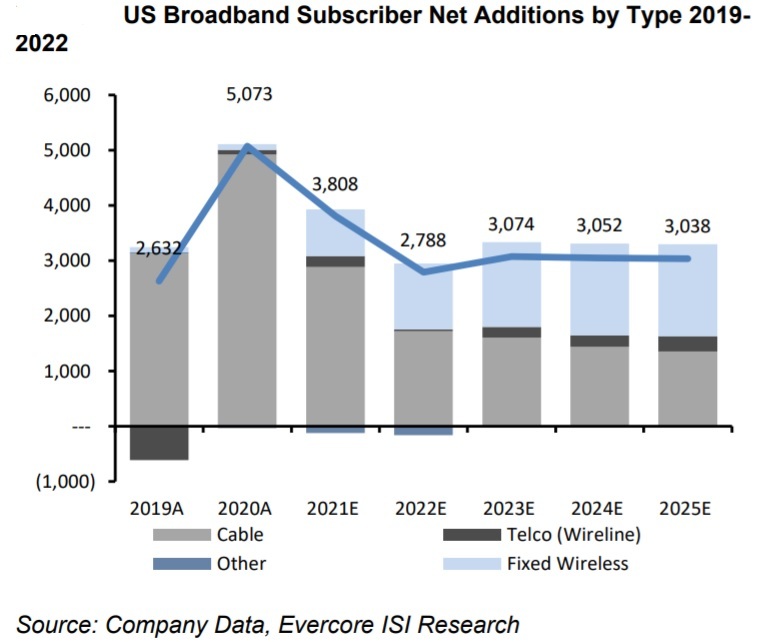
The financial analysts at Evercore predict that FWA services will gain a growing share of U.S. broadband new subscribe additions. Light Reading’s Mike Dano wrote the reasons are as follows:
- Verizon and T-Mobile are in the midst of deploying significant amounts of new spectrum into their networks. The addition of C-band spectrum (for Verizon) and 2.5GHz spectrum (for T-Mobile) will give them far more network capacity. And that’s important considering the average Internet household chews through almost 500 GB per month, according to OpenVault. The average smartphone user, meanwhile, consumes just 12 GB per month, according to Ericsson.
- Verizon and T-Mobile have finally shifted their FWA offerings from the test phase into the deployment phase. Although Verizon has been discussing FWA services for years, it finally started reporting actual customer numbers late last year (it ended the third quarter of 2021 with a total of 150,000 customers). Similarly, T-Mobile first outlined its FWA strategy in 2018, but officially launched its 5G FWA service in April – the company ended 2021 with 646,000 in-home Internet customers, well above its goal of 500,000. And both companies have recently cut FWA prices.
- The cable industry appears to be in the early stages of what MoffettNathanson analyst firm described as the “great deceleration.” According to the principal analyst Craig Moffett, this cable industry slowdown stems from such factors as a decrease in the rate of new household formation, increased competition from fiber providers – and FWA. He described the situation as a “concerning issue for cable investors, particularly if it appears that this is just a taste of what lies ahead.”
However, Craig is not convinced that FWA from telcos will mount a serious threat to cablecos Internet, partly because of capacity challenges operators will face as they bring subscribers onto the platform. They also wonder if it makes sense for mobile operators to get too aggressive with FWA, considering the much higher value on a per-gigabit basis they get from their respective mobile bases.
MoffettNathanson does acknowledge that both Verizon and T-Mobile have ramped up their focus on FWA even as AT&T takes a more cautious, targeted approach. Last week at an investor conference, AT&T CEO John Stankey said:
I believe that having some fixed high bandwidth infrastructure is going to be essential to being an effective networking company moving forward… Is fixed wireless going to be the best way to get a lot of bandwidth out to less densely populated rural areas? Yes, it probably will be. So is there a segment of the market where fixed wireless will apply and be effective? Sure, it will, and we’ll be in a position to have the right product to address those places.
But I don’t want to just simply say, well, that is the single solution that’s going to deal with what I would call the 70% of the business community, the 70% of the consumer population that are going to be pretty intensive users in some location, indeed, to have fixed infrastructure to support that over the long haul, given all the innovation that’s going to come……I see an opportunity for us to be very targeted and very disciplined around what we do (in FWA) and what used to be I hate using the term but traditional out of region markets, where good fiber deployment that supplements the strength of our wireless network.
Moffett wrote in a note to clients today:
There’s been a sea change in the rhetoric about fixed wireless broadband. We’re admittedly still struggling to understand it.
Until recently, Verizon and T-Mobile had, by turns, swung between aggressiveness and reticence. Investors will recall that in 2018, Verizon made bold claims about millimeter wave-based FWA. T-Mobile was rather skeptical at the time, not just about mmWave but even about FWA-over-mid-band. By 2019, Verizon had pulled in their horns, just as T-Mobile was first committing to bring FWA to rural Americans in a bid to sell their Sprint merger to regulators. At the start of last year, when all three of Verizon, AT&T, and T-Mobile held analyst days, T-Mobile upped the ante, forecasting 7-8M FWA customers by 2025. But Verizon was by then more cautious, committing only to a paltry $1B in revenue by 2024 (equating to perhaps 1.7M customers) and warning that their participation would be back end loaded. And AT&T was more cautious still, arguing that the capacity utilization implications made FWA unattractive.
Now, for the first time, Verizon and T-Mobile are pounding the table at the same time. What has changed? And what does it mean for the many plans for fiber overbuilds?
First, it’s important to consider the network capacity implications of fixed wireless. Most investors understand that the burden of serving homes with a wired broadband replacement is far greater than that of serving individual phones for mobility. But investors will also understand that network utilization isn’t uniform across all cell sites; there are cell sites with more excess capacity and there are cell sites with less.
The challenge for operators is to ensure that their FWA subscriptions fit as neatly as possible into the cell sites, or sectors of cell sites, with the most available capacity (a cell site will typically be divided into three sectors, each covering a 120 degree arc).
No operator wants to risk their high-value mobile service experience for the benefit of a few incremental low-value fixed subscriptions (as we’ll see shortly, the revenue per bit from a mobile customer is 30 to 50x higher than that for fixed).
Still, both T-Mobile and Verizon see FWA as promising. T-Mobile expects to have between 7 million to 8 million FWA subs by 2025, and views an addressable market of about 30 million homes that are suitable from a signal quality and capacity standpoint. T-Mobile has already noted that their 664K FWA customers include a mix of customers from relatively rural areas with limited or no wired broadband availability and those from suburbia who were previously cable subscribers.
Verizon, meanwhile, is committing to about $1 billion in FWA revenues by 2024, which MoffettNathanson equates to roughly 1.7 million customers (Verizon ended Q3 2021 with about 150,000 FWA subscribers).
Craig questions whether there’s enough bandwidth to go around to fulfill subscriber targets, and if getting aggressive with FWA makes business sense. He indicates that 5G telcos are getting desperate to find revenues after spending billions of dollars for licensed spectrum and 5G RAN buildouts.
With tens of billions of dollars of investment in spectrum already sunk, and with tens of billions more to come for network densification, one might imagine that carriers are desperate to find a more tangible revenue opportunity than one that depends on beating Amazon AWS at what is essentially just a next iteration of cloud services.
And when all is said and done, Craig is as puzzled as this author:
As we said at the outset… we’re struggling to understand. We’re struggling to understand why Verizon and T-Mobile suddenly see this (FWA) relatively low value use of network resources as attractive. We’re struggling to understand how, after an initial burst of growth, they will sustain that growth as sectors “fill up.” We’re struggling to understand why they have set such ambitious targets so publicly. And we’re struggling to understand why cable investors have come to expect that deployments of FWA and fiber should be treated as independent, or additive, risks. It doesn’t seem, to us, that it all adds up.
Opinion: We think an undisclosed reason for telco interest in FWA is that 5G mobile offers few, if any advantages over 4G and there is no roaming. Therefore, the 5G enhanced mobile broadband use case will continue to fail to gain market traction. 5G FWA can work well with a proprietary telco/cloud native 5G SA core network which could be shared by both 5G mobile and FWA subscribers (perhaps using the over hyped “network slicing”). So even though FWA was NOT an ITU IMT 2020 use case, it still has a lot of room to grow into a revenue generating service for wireless telcos.
References:
MoffettNathanson research note (only available to the firm’s clients)
Complete and Comprehensive Highlights of AT&T CEO’s Remarks at Citi Conference
Georgia Tech harvests 5G network power for wireless device charging
The dense focus of 5G creates a significant amount of power, much of which goes unused, so the project created an antenna system that can harvest it. In essence, the Georgia Tech discovery helps funnel 5G waves to devices, so they don’t have to rely on batteries, said Aline Eid, senior researcher in the Athena lab, which studies technologies for electromagnetic, wireless, and other applications. In the future, electricity providers could even offer power on demand “over the air,” Tentzeris said. “5G is going to be everywhere, especially in urban areas,” he added.
Because 5G networks are specifically built for high-bandwidth connection, the U.S. Federal Communications Commission (FCC) has authorized them to focus power much more densely than 4G networks. That means the high-frequency network will have a great deal of unused power that—unless “harvested”—will be wasted, he said.
That harvested energy could fuel the many battery-powered devices around us, like the sensors that help make up the IoT and that monitor conditions in homes, cities, autonomous cars, and even—via wearable electronics—inside our bodies.
“There’s been a lot of discussion of biomonitoring,” Tentzeris said. “In a wearable configuration, for monitoring glucose or blood pressure or sleep, you could have systems literally working for years and without the need for a battery charge.” The energy could be used for sensors in rugged environments where batteries aren’t an option, he added.
Power-as-a-service may well be a way for the telecom industry to supply electricity in the same way that many software makers today provide access to their applications in the cloud rather than through downloadable software, he added. Doing away with batteries will be a boon to the environment, Eid said.
“By 2025 you’ll be surrounded by billions of devices. That is the promise of IoT,” she said. “Billions of devices means billions of batteries being continuously replaced and continuously discarded at a huge cost to our environment, while there is power all around us.”
In order for a world without batteries to come to pass, researchers needed to find a way to tap into the 5G network. The Georgia Tech researchers believe they’ve found a way to do that.
Like its predecessors, the 5G networks service areas are divided into small geographical areas called cells. An antenna in each cell sends out radio waves that connect all the 5G wireless devices in that cell to the internet and to cellphones.
“People have attempted to do energy harvesting at high frequencies like 24 or 35 gigahertz before,” Eid said. But the antennas used only worked if they had line of sight to the base station.
Now, she and her colleagues developed a small, flexible Rotman-lens-based rectifying antenna (rectenna) system, capable, for the first time, of millimeter-wave harvesting in the 28-GHz band.
But to harvest enough power to supply low-power devices at long ranges requires antennas with large apertures. The problem with the larger antennas required to harvest 5G power is they have a narrowing field of view, which hinders operation from a 5G base station. In other words, the larger antennas cannot get a line of sight onto the 5G base stations, which exist in many more locations than those for 28G bands.
The Georgia Tech researchers created a system with a wide angle of coverage, which solves the problem of only being able to look from one direction, said Jimmy Hester, senior lab advisor.
“With this innovation, we can have a large antenna, which works at higher frequencies and can receive power from any direction. It’s direction-agnostic, which makes it a lot more practical,” he said.
The key to seeing in many directions is the researchers’ optical lens as an intermediate component between the receiving antennas and the rectifiers.
Operating just like an optical lens, their Rotman lens can see six fields of view at the same time. The Rotman lens is key for beam-forming networks and is frequently used in radar surveillance systems to see targets in multiple directions without physically moving the antenna system, Tentzeris said.
For their 5G device, they’ve devised a way to print the antennas and to tune the shape of the lens, which results in a structure with one angle of curvature on the beam-port side and another on the antenna side. This enables the antenna to map a set of selected radiation directions to an associated set of beam-ports; to “see” in six directions, he added.

Prototype of mm-Wave Energy Harvester. Image Credit: Georgia Tech
Incorporating 3-D printing into their technology, the researchers printed the palm-sized wave harvesters on many types of everyday flexible and rigid substrates. Providing 3D and inkjet printing options will make the system more affordable and accessible to a broad range of users, platforms, frequencies, and applications, Hester said.
For instance, the harvester on a wearable device would ensure it has the energy to keep counting your steps. In demonstrations, Georgia Tech’s technology achieved a 21-fold increase in harvested power compared with another harvesting device, Eid said.
“With this innovation, we can have a large antenna, which works at higher frequencies and can receive power from any direction. It’s direction-agnostic, which makes it a lot more practical,” noted Jimmy Hester, senior lab advisor and the CTO and co-founder of Atheraxon, a Georgia Tech spinoff developing 5G radio-frequency identification (RFID) technology.
“I’ve been working on energy harvesting conventionally for at least six years, and for most of this time it didn’t seem like there was a key to make energy harvesting work in the real world, because of FCC limits on power emission and focalization,” Hester said. “With the advent of 5G networks, this could actually work and we’ve demonstrated it. That’s extremely exciting — we could get rid of batteries.”
This work was supported by the Air Force Research Laboratory and the National Science Foundation (NSF) – Emerging Frontiers in Research and Innovation program. The work was performed in part at the Georgia Tech Institute for Electronics and Nanotechnology, a member of the National Nanotechnology Coordinated Infrastructure (NNCI), which is supported by the NSF (Grant ECCS-1542174).
References:
https://www.asme.org/topics-resources/content/harnessing-5g-excess-energy-could-end-battery-power
https://rh.gatech.edu/news/645735/leveraging-5g-network-wirelessly-power-iot-devices
A. Eid, et al., “5G as a wireless power grid.” (Scientific Reports, 2021) https://doi.org/10.1038/s41598-020-79500-x


